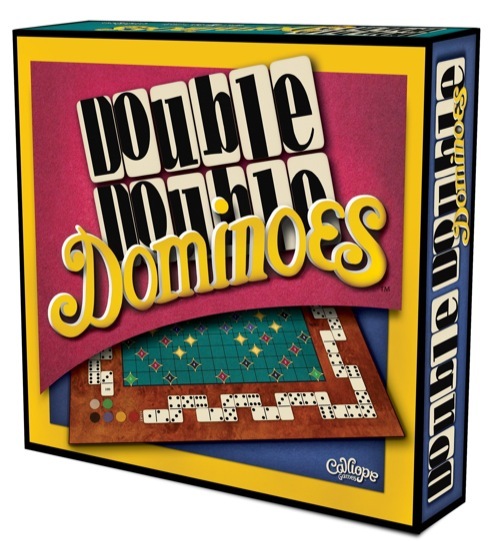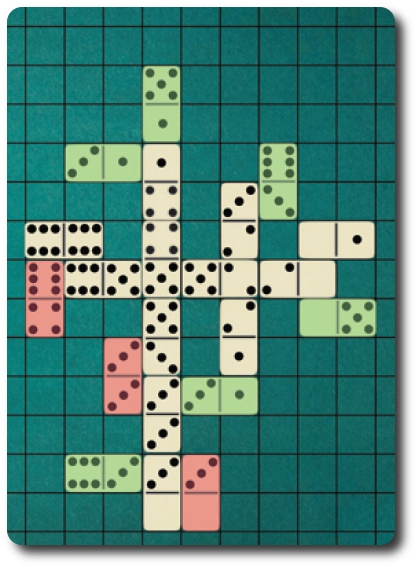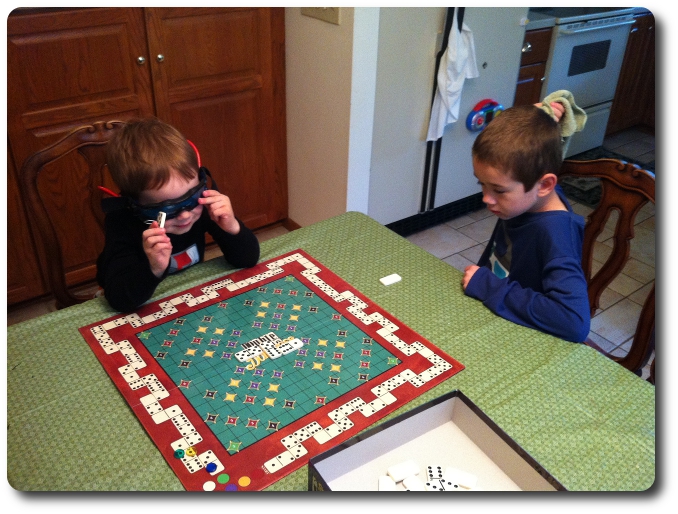
The Basics:
- For ages 4 and up (publisher suggests 8+)
- For 2 to 4 players
- About 45 minutes to complete
Geek Skills:
- Active Listening & Communication
- Counting & Math
- Logical & Critical Decision Making
- Pattern Matching
- Hand/Resource Management
Learning Curve:
- Child – Easy
- Adult – Easy
Theme & Narrative:
- None
Endorsements:
- Gamer Geek rejected!
- Parent Geek approved!
- Child Geek approved!
Overview
Double Double Dominoes, by Calliope Games, is a light abstract game where the players use dominoes to match numbers and score points. Players cannot only score on their turn, but also their opponent’s, which means the players at the table must be watching and communicating during the game at all times. Place a domino on the board and you could score points for yourself and for more than one of your opponents!
Double Double Dominoes is comprised of 56 dominoes, 4 scoring pieces (in four different colors, one for each player), and a large game board on which the game is played and the points are counted. The product is of high quality and very durable. While not flashy by any means (really very dull in presentation), it gets the job done.
Game Set Up
To set up the game, place the game board in the middle of the playing area and have each player select one scoring piece. Place these scoring pieces on the starting scoring area located on the domino scoring track that encircles the board.
The 56 dominoes should be shuffled (i.e. “randomized”) and placed face-down on the table where everyone can reach them. This area is referred to as the “boneyard”. Based on our experience, we found it a better use of space to simply place all the dominoes in one of the lids of the game box and have players blindly draw from there. Much more tidy. You will also need an area to discard unused dominoes. This area will be referred to as the “pit”. Again, based off our experience, we suggest you use the other, unused lid of the game box for this purpose. Just make sure you keep the two separate.
Each player draws three dominoes, keeping the “pips” or “dots” on the dominoes hidden from the other players at all times. Have each player look at their dominoes and then each player reveals the domino with the smallest number of dots. The player who has the smallest number of total dots on their revealed domino goes first.
You are now ready to play.
Playing the Game
A player’s turn is completed in just a few steps. These steps are as follows:
- Draw a Domino: the player randomly selects one domino from the boneyard and adds it to their hand for a total of 4 dominoes
- Play a Domino: the player plays a domino to the game board
- Score Points: all players record any points that are earned by advancing their scoring piece on the scoring track
- Repeat #2 if the domino played was a double domino, otherwise the player’s turn ends
If a player cannot play any of their dominoes to the board, they discard one or more of their dominoes to the pit, leaving them 3 dominoes in total.
Playing a Domino
Double Double Dominoes requires the player to always play a domino if one can be played on the board. In order for a domino to be playable, one of its two ends (separated by a solid line down the middle of the domino) must have the same number of dots as the domino it is connecting (i.e. “touching”) to. For example, a player could place a domino with one of its ends with 3 dots with a domino that had 3 dots, but not with a domino that had more or less than 3 dots. The only exception to this rule is the first domino played. The first domino must be played in the center of the board and it must cover the space with the star.
If the player plays a double domino (where both ends of the domino contain the same number of dots), they can choose to go again, but do not draw any more dominoes from the boneyard. The player can continue to play their dominoes as long as they play a double domino, for a maximum of four possible plays. If the player places a domino that is not a double domino, their turn ends. Note that scoring should always take place after each domino has been placed.

Example of a game in play - note that all the dominoes that are touching have matching values
Scoring Points
Players can score points two different ways. The first is by placing a domino on the board in a space that has a numbered value (values 1 through 5). The player scores that many points on the scoring track as soon as the domino is placed. If the domino placed is a double domino, the player scores double the points. For example, placing a double domino on a “3” would score the player “6” points.
The second way all players can score during a domino placement is when one of the two ends of the domino placed matches the space a scoring piece is located on the scoring track. That player immediately scores 3 points and advances their scoring piece accordingly. Bonus points are only scored once per domino played and for only one of the two ends, even if it is a double domino. For example, a player places a domino with a “3” and a “5” on it. The players who have their scoring pieces on the scoring track that show a domino that has a “3” or a “5” immediately get to move their scoring piece 3 spaces forward on the scoring track.
These points are accumulative. This means that the player who places a domino on the board can potentially score points based on where the domino was placed and if their scoring piece matches one of the two numbers on the domino.
Winning the Game
The game ends when one of the following three conditions are met:
- When one or more players reach a specific point total on the scoring track – this value is determined by the number of players
- At the end of the player’s turn who draws the last domino from the boneyard
- When there are no more places left on the game board to place a domino
The final score is determined by the value on the scoring track. The player with the most points wins the game. If two or more players are tied, add the dots of each domino still in the player’s hand. The player with the most dots wins the game.
To learn more about Double Double Dominoes, see the game’s official web page where you can also download a copy of the game rules.
Prediction
My little geeks are not big fans of games that are blatantly trying to teach them something. For example, Flash Cards are avoided like dirty diapers and having any parent using the phrase “makes learning fun” sends them scurrying to hide behind couches or finding the closest exist to escape into the backyard. Double Double Dominoes is, of course, more than just an education game, but the fact that the player is only matching numbers might make my little geeks believe they playing something that is trying to teach them something academic in nature. Yes, this might be a tough sell to the little geeks.
On the other hand, the game itself plays fairly quickly and can feel like a race. Not to mention that the portion of the game that is “teaching” the little geeks is disguised well enough as game mechanisms to make it feel like it is just part of the game. Hmm..the more I think upon it, the more I think the game will be well received. OK, disregard my earlier statement.
When I pitched the game to my little geeks, I did so by suggesting the game was like a race in which you block your opponent. My little geeks rather liked that idea and started talking excitedly about it. When I showed them the dominoes, their faces fell and they started asking where the cars were for the race. I then had to explain that not all race games include wheels. They were skeptical, but happy to continue.
Explaining the game took all of 5 minutes and my little geeks understood what was expected and how to play. I’m telling you, parents, the more games you play with your little geeks, the easier it is to teach and play games with them! It’s like taking up running. The first couple of weeks are Hell, but you get better and better at it. Before you know it, you are running miles when before you were whimpering about jogging a few feet. The same could be said about board games. Long gone are my days of playing Candy Land, but not before I played many, many games with mixed results.
After a quick demo and making certain both my little geeks understood the game, I asked them their thoughts. In between mouthfuls of Cheerios, they said the following:
“Neat looking game. Never played much with dominoes before.” ~ Liam (age 7)
“Look, Daddy! I can stack them really high!” ~ Nyhus (age 4)
Seconds later, the domino tower collapsed and we started the game. Let’s see if the game does well or falls to pieces like the domino skyscraper my 4-year-old created.
Final Word
Abstract games are a funny lot. People who play them either “get them” or have no idea what the intent of the game is. Oh, sure, they might understand the premise of the game, but not really able to grasp the game play or how to go about winning the game itself. Often, I have found that little geeks have a harder time with abstract games than adults. A more experienced mind is able to make connections and bring the abstract to more concrete terms fairly quickly. Young minds sometimes struggle trying to find a place to anchor context. Only through experience can a player start to pierce the abstract and find a base on which to build their understanding. This took time with my little geeks but they have since strengthened their Geeks Skill well enough to go about it fairly easily. As a result, my little geeks understood the game and played it well. Very well, in fact. My children were able to block me and steal my points a number of times.
Believe me when I say that a very small and selfish part of me wanted to send them to their room. Yes, that would teach them! NO ONE STEALS POINTS FROM DADDY!
The little geeks surpassed my expectations not only in their ability to comprehend the strategy and tactics of the game, but the ability to adapt to the changing board. Several times, my 4-year-old and 7-year-old made quiet comments about how displeased they were about certain moves I had made. And yet, on their next turn, they did not hesitate with their moves. These moves weren’t blind and lazy, either. They would take the time to think, and when they made their moves, it was with purpose. Outstanding.
Parents and Gamer Geeks had no problem with this game, which should come as no surprise. The game is not that complicated, after all. A few Parent Geeks remarked that they found the game to be very much like Scrabble because of the bonus points scattered about the board. For those who played Scrabble regularly, they found this to be a rewarding and familiar game mechanism that they took full advantage of. For those not familiar with Scrabble or games where placement of pieces could award higher points, the concept was quickly learned and utilized.

My two little geeks go head-to-head (one is wearing special "domino goggles" while I get their breakfast ready)
Gamer Geeks, this is a fun game but lacks the depth that game elitists with years of board game experience under their belt search for. The game is very straight forward and the level of complexity is based on what is available to you only. This makes some games very easy and some very complicated. But the complications and ease of play are all based on matching what is available at the time of your turn. There is very little you can do prior to or after to influence what will come later down the line. The double scoring makes the game a bit more interesting, but not to a point where it starts approaching Gamer Geek approval. Again, fun game, but not something you’ll look for or request with your regular gaming group.
Parent Geeks, this is a superb game for your family gaming table. Abstract and light with just enough thinking to keep everyone at the table involved without having them overheat their heads. The game allows for table conversation without distracting from the game or slowing it down. Choices are simple and few, which means that no player should be vapor locked for long when it comes to their turn. The game is abstract but not inaccessible. Your family and friends who are non-gamers will be able to grasp the game and play it easily as long as they don’t get befuddled by the domino placement. If they do become confused, a few demonstration should be all that is necessary to get them back on track.
Child Geeks, this is a fun game to learn and an even more fun game to play. If you are not familiar with dominoes, this is a great way to be introduced to them using a game board to help you keep everything organized. You’ll have to match numbers and count, but never to a point where it is too complex. If you are still learning your numbers and counting, this is a great game to help you strengthen those Geek Skills! Be sure to look for spaces that allow you to build on extra points and always watch what the other players do so you don’t lose out on points or give them away freely!
Double Double Dominoes was well received at my household and will be a game I will be most pleased to bring to the table upon request or when asked to bring a game to our next dinner party with friends. The only downside to the game is the number of players that can play it. You could buy another set and play up to 6 players if you wanted, but as a 4-player game, it works very well. Presentation is fairly “blah”, but it isn’t necessary to the game play whatsoever. The end result is a fun game that provides just enough challenge to keep you engaged and smiling throughout. If you are looking for a new family board game, give Double Double Dominoes a try.
This game was given to Father Geek as a review copy. Father Geek was not paid, bribed, wined, dined, or threatened in vain hopes of influencing this review. Such is the statuesque and legendary integrity of Father Geek.




Pingback: Father Geek reviews Double Double Dominoes : Funlab